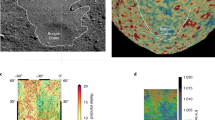Abstract
The 100-km-diameter Popigai structure was formed 35.7 Ma ago in a target consisting of ~1–1.5 km of Proterozoic, Cambrian and Permian sedimentary rocks overlying Archean crystalline basement. The structure is characterized by a gravity anomaly low of −35 mGal amplitude, one of the largest magnitude gravity anomalies associated with a terrestrial impact structure. Superimposed on the gravity low is a concentric ring-shaped high, ~45 km in diameter, that coincides with uplifted Archean basement. Magnetic data indicate a −300 nT amplitude simple anomaly low over the structure. Both the gravity and magnetic signatures of Popigai differ from those of most other impact structures of comparable size, being distinguished by the lack of a central circular gravity high related to a central structural uplift or high-amplitude magnetic anomalies caused by thick melt/suevite deposits.
Two-dimensional forward modelling of an E-W profile through the crater is initialized using existing and recently-acquired petrophysical data and a structural cross-section based on geologic mapping and drill hole information. Petrophysical measurements indicate that lithologies making up the crater fill have susceptibilities nearly two orders of magnitude less than those determined for the basement. Crater fill densities are also considerably lower, with values up to 0.4 gcm−3 less than the surrounding target rocks. Gravity data modelling indicates the presence of low-density crater fill plus an extensive region of reduced-density fractured basement. The magnetic data also suggest a significant volume (down to ~5 km depth) of fractured basement below the true crater floor.
Access this chapter
Tax calculation will be finalised at checkout
Purchases are for personal use only
Preview
Unable to display preview. Download preview PDF.
Similar content being viewed by others
References
Allen CC, Gooding JL, Keil K (1982) Hydrothermally altered impact melt rock and breccia: contributions to the soil of Mars. Journal of Geophysical Research 87: 10083–10101
Beals CS, Innes MJS, Rottenberg JA (1963) Fossil meteorite craters. In: Middlehurst BM, Kuiper GP (eds) The Moon, Meteorites and Comets. University of Chicago Press, Chicago, pp 235–284
Cisowski SM, Fuller M (1978) The effect of shock on the magnetism of terrestrial rocks, Journal of Geophysical Research 83: 3441–3458
Dyrelius D (1988) The gravity field of the Siljan ring structure. In: Boden A, Eriksson KG (eds) Deep Drilling in Crystalline Bedrock, Vol 1, The deep gas drilling in the Siljan impact structure, Sweden and astroblemes. Springer-Verlag, New York, pp 85–94
Grieve RAF, Pilkington M (1996) The signature of terrestrial impacts. Australian Geological Survey Organisation Journal 16: 399–420
Grieve RAF, Dence MR, Robertson PB (1977) Cratering processes: As interpreted from the occurrence of impact melts. In: Roddy DJ, Pepin RO, Merrill RB (eds) Impact and Explosion Cratering. Pergamon Press, New York, pp 791–814
Hargraves RB, Perkins WE (1969) Investigations of the effect of shock on natural remanent magnetism. Journal of Geophysical Research 74: 2576–2589
Hastings DA, Dunbar PK (1998) Development and assessment of the Global Land One-km Base Elevation Digital Elevation Model ( GLOBE ). International Society of Photogrammetry and Remote Sensing Archives, 32: 218–221.
Henkel H (1992) Geophysical aspects of meteorite impact craters in eroded shield environment, with special emphasis on electric resistivity. Tectonophysics 216: 63–90
Henkel H (1994) Standard diagrams of magnetic properties and density–A tool for understanding magnetic petrology. Journal of Applied Geophysics 32: 43–53
Hittelman A, Buhmann R, Meyers H (1991) USSR magnetic anomaly data. In: Taylor P (ed)
IAGA Working Group V-9 Newsletter 3, Goddard Space Flight Center, Greenbelt
Innes MJS (1964) Recent advances in meteorite crater research at the Dominion Observatory
Ottawa, Canada. Meteoritics 2: 219–241
Korhonen JV, Säävuori H, Kivekäs L (1997) Petrophysics in the crustal model program of Finland. In: Autio S (ed) Current Research 1995–1996, Geological Survey of Finland Special Paper 23: 157–173
Lauren L, Lehtovaara J, Bostrom R, Tynni R (1978) On the geology of the circular depression at Söderfjärden, western Finland. Geological Survey of Finland Bulletin 297: 1–38
Masaitis VL (1994) Impactites from Popigai crater. In: Dressler BO, Grieve RAF, Sharpton VL (eds) Large Meteorite Impacts and Planetary Evolution. Geological Society of America Special Paper 293: 153–162
Masaitis VL (1998) Popigai crater: Origin and distribution of diamond-bearing impactites. Meteoritics and Planetary Science 33: 349–359
Masaitis VL, Mikhaylov MV, Selivanovskaya TV (1975) The Popigai meteorite crater (in Russian). Nauka Press, Moscow, 124 pp (English translation: NASA TT F-16900, 1976 )
Masaitis VL, Danilin VN, Mashchak MS, Raikhlin AI, Selivanovskaya TV, Shadenkov EM (1980) The geology of astroblemes (in Russian). Nedra Press, Leningrad, 231 pp (English translation: NASA TM-77743, 1984 )
Pilkington M, Grieve RAF (1992) The geophysical signature of terrestrial impact craters. Reviews of Geophysics 30: 161–181
Plado J, Pesonen LJ, Puura V (1999) Effect of erosion on gravity and magnetic signatures of complex impact structures: Geophysical modeling implications. In: Dressler BO, Sharpton VL (eds) Large Meteorite Impacts and Planetary Evolution II. Geological Society of America Special Paper 339: 229–240
Pohl J, Bleil U, Hornemann U (1975) Shock magnetization and demagnetization of basalt by transient stress up to 10 kbar. Journal of Geophysics 41: 23–41
Savrasov DI (1967) Physical features of rocks in Western Yakutiya (in Russian). In: Fotiadi EE (ed) Geological results of the geophysical investigation in Siberia and the Far East. Nauka Press, Novosibirsk, 514 pp
Scott RG, Pilkington M, Tanczyk EI (1997) Magnetic investigations of the West Hawk, Deep Bay and Clearwater impact structures, Canada. Meteoritics and Planetary Science 32: 293–308
Author information
Authors and Affiliations
Editor information
Editors and Affiliations
Rights and permissions
Copyright information
© 2002 Springer-Verlag Berlin Heidelberg
About this chapter
Cite this chapter
Pilkington, M., Pesonen, L.J., Grieve, R.A.F., Masaitis, V.L. (2002). Geophysics and Petrophysics of the Popigai Impact Structure, Siberia. In: Plado, J., Pesonen, L.J. (eds) Impacts in Precambrian Shields. Impact Studies. Springer, Berlin, Heidelberg. https://doi.org/10.1007/978-3-662-05010-1_4
Download citation
DOI: https://doi.org/10.1007/978-3-662-05010-1_4
Publisher Name: Springer, Berlin, Heidelberg
Print ISBN: 978-3-642-07803-3
Online ISBN: 978-3-662-05010-1
eBook Packages: Springer Book Archive




